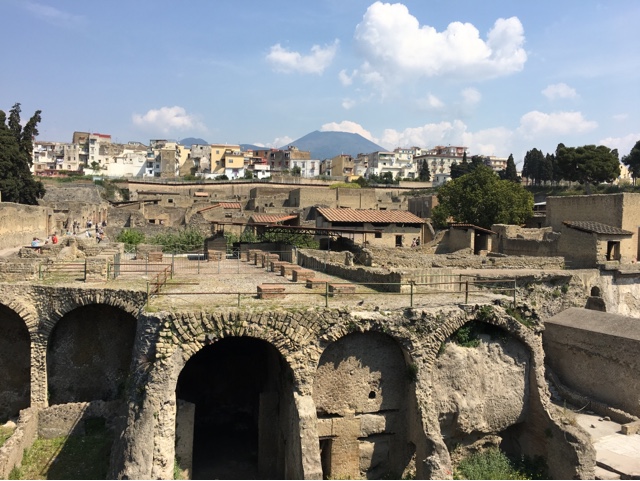After an amazing morning at the Naples Museum, we got back on the bus to head to Herculaneum and Pompeii. When we arrived at Herculaneum, we ate our sack lunches of salami, cheese, bread, and salad outside in the sun.
Walking through Herculaneum was an entrancing experience. I was expecting an experience similar to Ostia, where, since the city fell slowly into disuse, it takes quite the imagination to picture the city as something modern and full of life. This was definitely not the case. Herculaneum was covered in pyroclastic material within minutes of Vesuvius's eruption in 79 AD, and so the city was much more well preserved. Its resulting status as a mass grave as well as a city also adds a sense of immediacy to Herculaneum.
We wandered through the original roads of the city, encountering many intricate mosaics along the way. We walked inside several houses, which I was amazed by. It's one thing to learn about the Roman way of life in a textbook, but it is another thing entirely to stand in someone's house, where they lived their life 2,000 years ago.
We then hopped back on the bus to head to Pompeii.
My first impression of Pompeii was of its almost inconceivable size. At the back of my mind, I knew that it was an entire city that had been preserved and later excavated, but I hadn't yet translated that into the sheer size of the ruins. As we walked through the city, I was immersed in the feeling of Pompeii as it must have been in antiquity.
Winding our way through the ancient streets, we made our way to the House of Mystery right outside city's limits.
It had an exquisitely preserved structure, as well as beautiful frescoes. These frescoes included those detailing the initiation rituals for the cult of Mithras, which are consulted as a important resource on the secret cult.
Herculaneum and Pompeii, two cities that were frozen in time by the eruption of Mount Vesuvius, shared, at least for me, an eerie tone overall. Whereas in Ostia the city fell into disuse over time, life in Herculaneum and Pompeii ended suddenly and violently. Having visited Mount Vesuvius and the Naples Museum in addition to Herculaneum and Pompeii, I am able to vividly imagine what life must have been like in these cities like I never have been able to before. This wealth of firsthand experience walking through the towns, seeing objects excavated from them, and hiking the mountain that destroyed them has given me a greater appreciation for the events surrounding Pompeii and the eruption of Vesuvius in the year 79.















No comments:
Post a Comment